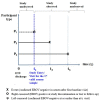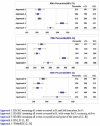Statistical methodologies for evaluation of the rate of persistence of Ebola virus in semen of male survivors in Sierra Leone
- PMID: 36197875
- PMCID: PMC9534448
- DOI: 10.1371/journal.pone.0274755
Statistical methodologies for evaluation of the rate of persistence of Ebola virus in semen of male survivors in Sierra Leone
Abstract
The 2013-2016 Ebola virus (EBOV) outbreak in West Africa was the largest and most complex outbreak ever, with a total number of cases and deaths higher than in all previous EBOV outbreaks combined. The outbreak was characterized by rapid spread of the infection in nations that were weakly prepared to handle it. EBOV ribonucleic acid (RNA) is known to persist in body fluids following disease recovery, and studying this persistence is crucial for controlling such epidemics. Observational cohort studies investigating EBOV persistence in semen require following up recently recovered survivors of Ebola virus disease (EVD), from recruitment to the time when their semen tests negative for EBOV, the endpoint being time-to-event. Because recruitment of EVD survivors takes place weeks or months following disease recovery, the event of interest may have already occurred. Survival analysis methods are the best suited for the estimation of the virus persistence in body fluids but must account for left- and interval-censoring present in the data, which is a more complex problem than that of presence of right censoring alone. Using the Sierra Leone Ebola Virus Persistence Study, we discuss study design issues, endpoint of interest and statistical methodologies for interval- and right-censored non-parametric and parametric survival modelling. Using the data from 203 EVD recruited survivors, we illustrate the performance of five different survival models for estimation of persistence of EBOV in semen. The interval censored survival analytic methods produced more precise estimates of EBOV persistence in semen and were more representative of the source population than the right censored ones. The potential to apply these methods is enhanced by increased availability of statistical software to handle interval censored survival data. These methods may be applicable to diseases of a similar nature where persistence estimation of pathogens is of interest.
Conflict of interest statement
The authors have declared that no competing interests exist.
Figures



References
-
- WHO. WHO Fact sheet N°103. Ebola virus disease Geneva2016 [updated January 2016; cited 2016 17 April 2016]. Available from: http://www.who.int/mediacentre/factsheets/fs103/en/.
-
- WHO. Interim Guidance Geneva: The World Health Organization; 2016 [updated 11 April 2016]. Available from: http://apps.who.int/iris/bitstream/10665/204235/1/WHO_EVD_OHE_PED_16.1_e....
-
- Oleribe OO, Salako BL, Ka MM, Akpalu A, McConnochie M, Foster M, et al.. Ebola virus disease epidemic in West Africa: lessons learned and issues arising from West African countries. Clin Med (Lond). 2015;15(1):54–7. Epub 2015/02/05. doi: 10.7861/clinmedicine.15-1-54 PubMed Central PMCID: PMC4954525. - DOI - PMC - PubMed
-
- Chughtai AA, Barnes M, Macintyre CR. Persistence of Ebola virus in various body fluids during convalescence: evidence and implications for disease transmission and control. Epidemiol Infect. 2016;144(8):1652–60. Epub 2016/01/26. doi: 10.1017/S0950268816000054 ; PubMed Central PMCID: PMC4855994. - DOI - PMC - PubMed
-
- Thorson A, Formenty P, Lofthouse C, Broutet N. Systematic review of the literature on viral persistence and sexual transmission from recovered Ebola survivors: evidence and recommendations. BMJ Open. 2016;6(1):e008859. Epub 2016/01/09. bmjopen-2015-008859 [pii] doi: 10.1136/bmjopen-2015-008859 . - DOI - PMC - PubMed
Publication types
MeSH terms
Substances
Grants and funding
LinkOut - more resources
Full Text Sources
Medical

